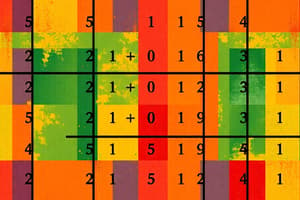Podcast
Questions and Answers
Why is it important to avoid anchoring to the platform when operating near a water source?
Why is it important to avoid anchoring to the platform when operating near a water source?
Anchoring to the platform could cause the EWP to tip into the water, creating a hazardous situation.
Besides having a rescue boat, what other element is important to have for water-based rescues, and why is it required?
Besides having a rescue boat, what other element is important to have for water-based rescues, and why is it required?
A rescue plan should be created so you know precisely what steps to take and what role you play in the event of an emergency.
Explain the purpose of using a spotter during operations near water and outline a scenario where their role would be critical.
Explain the purpose of using a spotter during operations near water and outline a scenario where their role would be critical.
The spotter's role is to observe the EWP and surrounding environment for any potential hazards or instability, which could be critical if the water level starts to rise unexpectedly.
During operations near a water source, why is having an "Emergency retrieval system" important, and what might this system entail?
During operations near a water source, why is having an "Emergency retrieval system" important, and what might this system entail?
Why is wearing a life jacket considered an added precaution when setting up an EWP (Elevated Work Platform) near a water source?
Why is wearing a life jacket considered an added precaution when setting up an EWP (Elevated Work Platform) near a water source?
Flashcards
Wear a life jacket
Wear a life jacket
Always wear a life jacket near a water source to prevent drowning in case of an accidental fall into the water.
NEVER anchor to the platform!
NEVER anchor to the platform!
Do not anchor the EWP (Elevated Work Platform) to the platform to prevent instability that leads to the EWP tipping over.
Have a Rescue boat
Have a Rescue boat
Always have a rescue boat available to perform swift rescues if someone falls into the water.
Have a Rescue plan
Have a Rescue plan
Signup and view all the flashcards
Use a spotter
Use a spotter
Signup and view all the flashcards
Study Notes
- A matrix is a rectangular array of numbers or symbols.
- An $m \times n$ matrix has $m$ rows and $n$ columns.
Matrix Examples
- $\begin{bmatrix} 1 & 2 & 3 \ 4 & 5 & 6 \end{bmatrix}$ is a $2 \times 3$ matrix.
- $\begin{bmatrix} 1 \ 0 \ 1 \end{bmatrix}$ is a $3 \times 1$ matrix.
- $\begin{bmatrix} 1 & 2 & 3 \ 4 & 5 & 6 \end{bmatrix}$, $\begin{bmatrix} a & b \ c & d \end{bmatrix}$, $\begin{bmatrix} 1 \ 0 \ 1 \end{bmatrix}$, $\begin{bmatrix} 1 & 2 \end{bmatrix}$ are valid matrices
Special Matrices
- Square Matrix: Same number of rows and columns, example $\begin{bmatrix} 1 & 2 \ 3 & 4 \end{bmatrix}$
- Identity Matrix: Denoted by $I$, a square matrix with 1s on the main diagonal and 0s elsewhere, example $I = \begin{bmatrix} 1 & 0 \ 0 & 1 \end{bmatrix}$
- Zero Matrix: All entries are 0 , example $\begin{bmatrix} 0 & 0 \ 0 & 0 \end{bmatrix}$
- Diagonal Matrix: Square matrix in which entries outside the main diagonal are all zero, example: $\begin{bmatrix} 1 & 0 \ 0 & 2 \end{bmatrix}$
- Upper Triangular Matrix: Matrix in which all entries below the main diagonal are zero, example: $\begin{bmatrix} 1 & 2 \ 0 & 3 \end{bmatrix}$
- Lower Triangular Matrix: Matrix in which all entries above the main diagonal are zero, example: $\begin{bmatrix} 1 & 0 \ 2 & 3 \end{bmatrix}$
- Transpose: Given a matrix A, its transpose, denoted by $A^T$, is obtained by interchanging rows and columns.
- If $A = \begin{bmatrix} 1 & 2 \ 3 & 4 \end{bmatrix}$, then $A^T = \begin{bmatrix} 1 & 3 \ 2 & 4 \end{bmatrix}$
Matrix Operations
- Matrices can be added or subtracted if they have the same dimensions.
- If $A = [a_{ij}]$ and $B = [b_{ij}]$ are both $m \times n$ matrices, then $A + B = [a_{ij} + b_{ij}]$ and $A - B = [a_{ij} - b_{ij}]$.
- If $A = [a_{ij}]$ is a matrix and $c$ is a scalar, then $cA = [ca_{ij}]$.
- If $A$ is an $m \times n$ matrix and $B$ is an $n \times p$ matrix, then the product $AB$ is an $m \times p$ matrix.
- The $(i, j)$-th entry of $AB$ is given by: $(AB){ij} = \sum{k=1}^{n} a_{ik}b_{kj}$
Properties of Matrix Multiplication
- Associative: $(AB)C = A(BC)$
- Distributive: $A(B + C) = AB + AC$ and $(A + B)C = AC + BC$
- Identity: $AI = IA = A$
Determinant
- The determinant is a scalar value that can be computed from the elements of a square matrix, encodes certain properties of the linear transformation described by the matrix.
- The determinant of a matrix $A$ is denoted as det$(A)$ or $|A|$.
$2 \times 2$ Matrix
- For a $2 \times 2$ matrix $A = \begin{bmatrix} a & b \ c & d \end{bmatrix}$, the determinant is: $det(A) = ad - bc$
$3 \times 3$ Matrix
- For a $3 \times 3$ matrix, computed using the rule of Sarrus or cofactor expansion.
- Example using cofactor expansion: $A = \begin{bmatrix} a & b & c \ d & e & f \ g & h & i \end{bmatrix}$
- $det(A) = a(ei - fh) - b(di - fg) + c(dh - eg)$
Properties of Determinants
- $det(I) = 1$
- $det(A^T) = det(A)$
- If $A$ has a row or column of zeros, then $det(A) = 0$
- If $A$ has two identical rows or columns, then $det(A) = 0$
- If $B$ is obtained from $A$ by interchanging two rows or columns, then $det(B) = -det(A)$
- If $B$ is obtained from $A$ by multiplying a row or column by a scalar $k$, then $det(B) = k \cdot det(A)$
- $det(AB) = det(A) \cdot det(B)$
Inverse
- The inverse of a square matrix $A$, denoted as $A^{-1}$, is a matrix such that $AA^{-1} = A^{-1}A = I$, where $I$ is the identity matrix.
$2 \times 2$ Matrix
- For a $2 \times 2$ matrix $A = \begin{bmatrix} a & b \ c & d \end{bmatrix}$, the inverse is: $A^{-1} = \frac{1}{ad - bc} \begin{bmatrix} d & -b \ -c & a \end{bmatrix}$, only if $ad - bc \neq 0$
Properties of Inverses
- $(A^{-1})^{-1} = A$
- $(cA)^{-1} = \frac{1}{c}A^{-1}$
- $(AB)^{-1} = B^{-1}A^{-1}$
- $(A^T)^{-1} = (A^{-1})^T$
- A matrix is invertible if and only if $det(A) \neq 0$.
Studying That Suits You
Use AI to generate personalized quizzes and flashcards to suit your learning preferences.




